
Welcome Back!
Whew! Just coming off one of our busiest weekends of the year … The Great Wisconsin Quilt Show in Madison, Wisconsin. It’s also my favorite quilting weekend of the year! Rick, our staff and I were so happy to see so many of you there! We got to meet lots of new quilters, too! Thank you for supporting The Quilting Connection at such a huge, amazing and fun event!!!
You know, quilt shows give us the opportunity to talk with quilters of all experience levels about the full range of longarm quilting possibilities. I love it all!
But I have to tell you, when I get the chance to demonstrate even a portion of the capabilities of computerized longarm quilting, that’s the absolute best! You can just see quilters’ minds being blown away, and then their wheels turning with ideas and questions!
So, coming off that high, that’s what I’m going to try to share with you today. We’ve covered free-motion quilting, its sub-set … ruler-work, and pantograph longarm quilting. Now I want to give you some sense of just what computerized longarm quilting can do!
What is Computerized Longarm Quilting?
Very basically, computerized longarm quilting is using a computer-guided system to automate the process of stitching designs onto a quilt.
The longarm machine is fitted with the computer hardware, software and communication devices needed to guide the machine. A simple track system is also installed on the back table of the longarm frame to guide the machine head as it stitches the computerized designs.
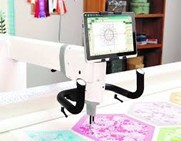
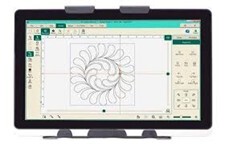
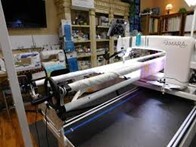
The different longarm companies use different computer systems for their computerized quilting. For example, when you quilt on Handi Quilter machines, you’re using Pro-Stitcher Premium or Pro-Stitcher Lite. When you quilt on APQS machines, you’re using Quilt Path.
The basic process
For quilters unfamiliar with how computerized longarm quilting works, I think their greatest misconception is that once the quilt is loaded on the frame and the computer is programmed, the longarm simply runs and quilts the quilt from start to finish. It’s not that simple.
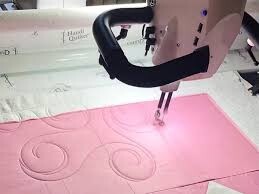
If quilting an edge-to-edge design, a design that repeats from left to right and top to bottom covering the complete quilt, the basic process goes something like this:
- Load the quilt back, top and batting.
- Baste the top edge of the quilt and as much of the sides as available in the frame.
- Select the quilting design you want to use from the computer.
- Resize the design as wanted/needed. (See Benefits below for more information.)
- Build the pattern horizontally and vertically so that it is large enough to cover the complete quilt top.
- Set up the quilt space on the computer to define the top, side and bottom edges of your quilt.
- Make sure the design you built properly fits into the quilt space.
- Save the quilt design you’ve built for this specific quilt … just in case complications arise!
- Tell the computer to start quilting. But wait! you’re not done …
- When the computer completes the first row, advance the quilt to the next row.
- Baste both sides of the quilt.
- Realign the quilt pattern so the computer knows you moved the quilt.
- Tell the computer to start quilting.
- Rinse and repeat until you’re on the last row of the quilt.
- Baste both remaining sides of the quilt as well as the bottom edge.
- Realign the quilt pattern so the computer knows you moved the quilt AND make adjustments so the computer knows what portion of the row is needed to cover the remaining area of the quilt top.
- Tell the computer to start quilting the final row.
You’re most definitely involved in the quilting, it’s just that the computer is directing the actual stitching. And in addition to the steps listed above, you’re still monitoring for thread breaks, bobbin changes, tension issues, etc.
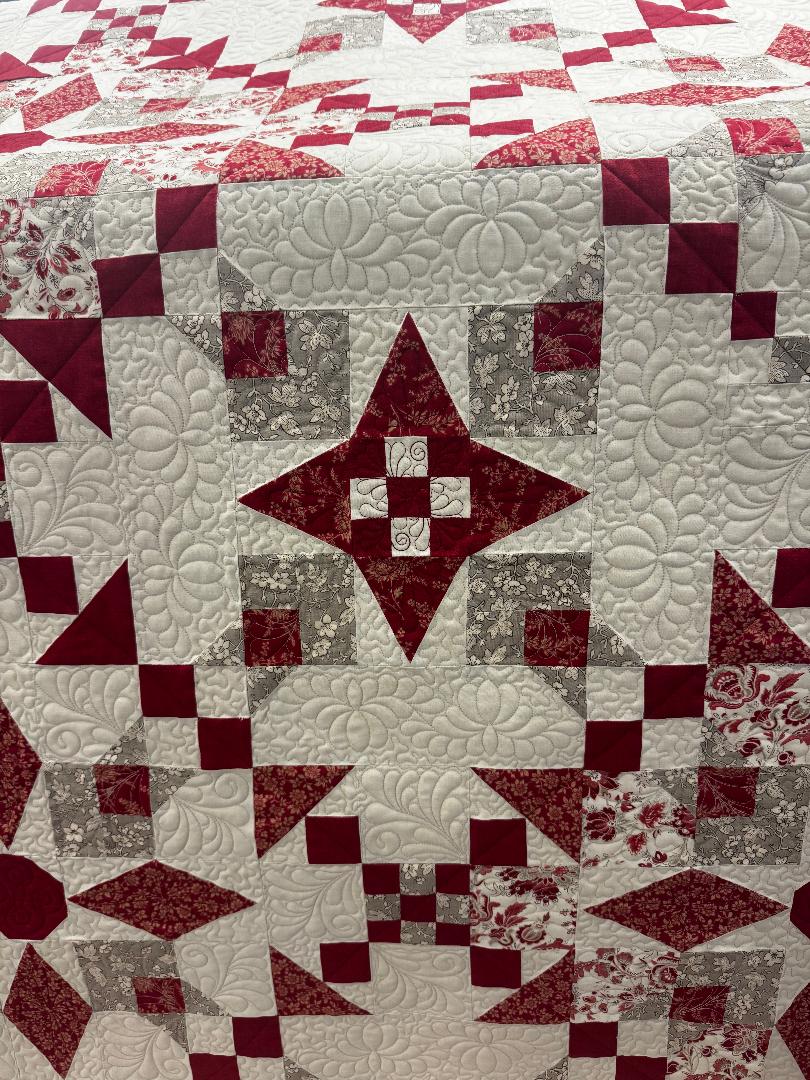
If you’re custom quilting, you’re even more involved with setting up quilting spaces and designs specific to your blocks or other areas of your quilt top. You may be using motifs from your computer’s library or you may be using more advanced software (e.g., Pro-Stitcher Designer) to create your own designs.
The possibilities with computerized longarm quilting are endless just as they are with free-motion quilting. The main difference is you’re using the computer as a tool to create designs and then to direct the actual stitching.
Benefits of Computerized Longarm Quilting
There are so many benefits to computerized longarm quilting, but I think what quilters recognize first and foremost is the accuracy, consistency and precision of computerized quilting.
Other benefits include:
- Ability to stitch complex motifs that would be difficult to accomplish with free-motion or pantograph quilting.
- Flexibility of scaling and modifying designs. While a pattern defaults to a specific size, digitized designs can be resized to complement the style, construction and purpose of the quilt. The main limitation becomes the throat space of your longarm.
- Ability to rotate, mirror or combine designs.
- You can easily save your designs to be used in multiple locations on the same quilt or on multiple quilts.
- Each of the computerized systems come with hundreds of designs, but you can also purchase designs that you can easily add to your library. Or you can create and store your own designs.
- Reduced physical strain on the body. While you have to be aware of what your longarm is doing at all times, you can still sit or do other things while the actual stitching is happening.
- Possibility of saving time. This isn’t a given. Depending on the complexity and density of the design you choose, you may or may not save time on your quilting. If time is a factor for you, doing an open edge-to-edge design on a large quilt may prove helpful.
Tips to Enhance Your Computerized Longarm Quilting
While the computer is directing the stitching when you use this method of quilting, you must remember that you’re directing the computer. It’s just a sophisticated tool that’s following your instructions.
These tips will help promote your success and enjoyment with computerized quilting.
- Build your comfort level with the quilting software. Start with the basics. Focus on learning one or two concepts at a time.
- Start with simple quilting. Basic edge-to-edge patterns can be a good place to begin.
- Practice! There is a learning curve!
- Jennifer, one of our staff members, tells longarmers new to computerized quilting to have 10 – 12 quilt tops and backs ready to go. You want to complete several quilts in a relatively short period of time to internalize the process and build an understanding of what you’re doing and why you’re doing it!
- You also want to build your understanding of design placement and scaling.
- Take advantage of training opportunities. Not only will you get answers to your questions, but you’ll come away with new ideas and techniques that will continue to elevate your skills. Your confidence will grow. And you’ll have the opportunity to build a network of other quilters to share future questions and successes with!
REMINDER: If you’ve purchased either your Pro-Stitcher or Quilt Path computer systems through The Quilting Connection, you have lifelong access to our edge-to-edge and custom computerized training. We know you can’t learn everything in a single sitting or maybe you haven’t been able to use your longarm for a while. If you need a refresher, please contact us!
And, if you want to take your computerized longarm skills to the next level, keep reading. You’ll find information on an Advanced Pro-Stitcher class that I’ll be teaching later this month!
So that’s a basic introduction to computerized longarm quilting. I wish you could hear me talk through these highlights so you could experience even a bit of the passion I have for this method of quilting! (You know … there’s just such an opportunity coming up soon! Read on!)
My closing thoughts on this topic? Please don’t feel that using the computer undercuts your value or skill level as a longarm quilter! The computer is a sophisticated tool that can elevate your longarming skills. It doesn’t eliminate artistry – it enhances it!
What are your thoughts on computerized quilting? I’d love to know if you get as excited about the possibilities offered by using the computer as I do! And please let me know if you’re encountering any problems or feeling stuck. I’d love to help!
For now, let’s wrap up with reminders of what’s happening at The Quilting Connection!
In-person Classes at Quilting Connection!
Okay … want to take your computerized longarm quilting skills to the next level? Here’s that opportunity I promised!
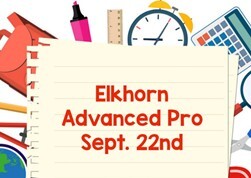
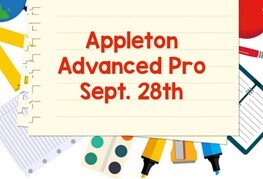
Advanced Pro-Stitcher Class (Elkhorn)
Monday, September 22, 2025
9 AM – 4 PM (Lunch Included)
or
Advanced Pro-Stitcher Class (Appleton)
Sunday, September 28, 2025
9 AM – 4 PM (Lunch Included)
I’ll teach you how to place and stitch borders, turn a piece of edge-to-edge design into a block design, use the mark feature, stitch out triangle designs, and crop designs. We might even get a chance to learn the magic of mandalas! You’ll finish a hands-on project using Pro-Stitcher!
Now, if you want to build your free-motion and/or ruler-work skills, check out these opportunities!
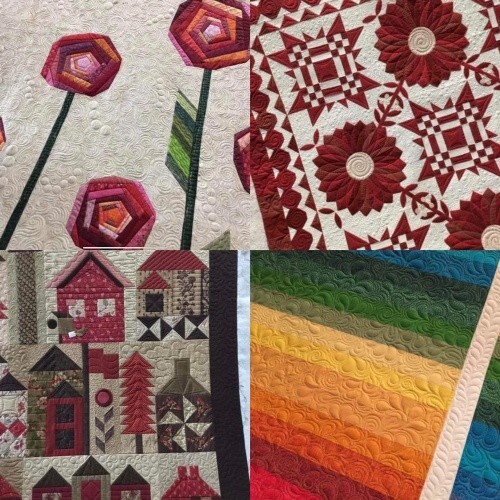
Basic Free-motion Class with Wendy Fuller
Friday, October 17, 2025 (Appleton)
or
Saturday, October 18, 2025 (Elkhorn)
9:00 AM – 4:00 PM (lunch included)
These are small group, hands-on classes. Wendy will introduce you to a variety of free-motion quilting designs and the various techniques that can be used to produce them. You’ll look at the many ways to use the designs to fill your quilt blocks and borders.
You’ll also get plenty of hands-on time at the longarm, and you’ll go home with a practice piece to refer to and build on in the future!
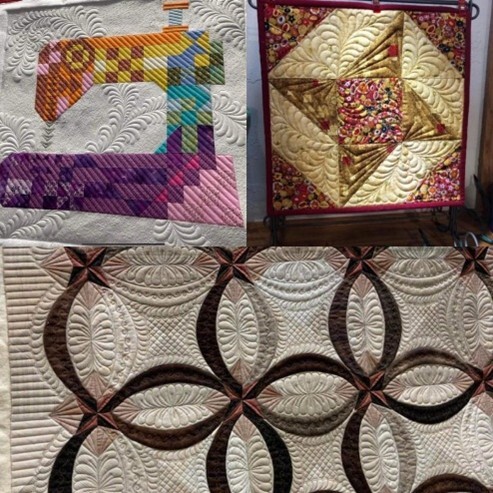
Feathers Flowers and Leaves Class with Wendy Fuller
Friday, November 7, 2025 (Appleton)
or
Saturday, November 8, 2025 (Elkhorn)
9:00 AM – 4:00 PM (lunch included)
Want to broaden your free-motion repertoire?
Wendy will guide you in easy and popular ways to create
feathers, leaves, and flowers.
You’ll explore the many ways to use them in overall designs, blocks, and borders!
You’ll do a bit of drawing to introduce you to some designs, then you’ll get busy on the longarm practicing them. And, of course, you’ll go home with your practice piece!
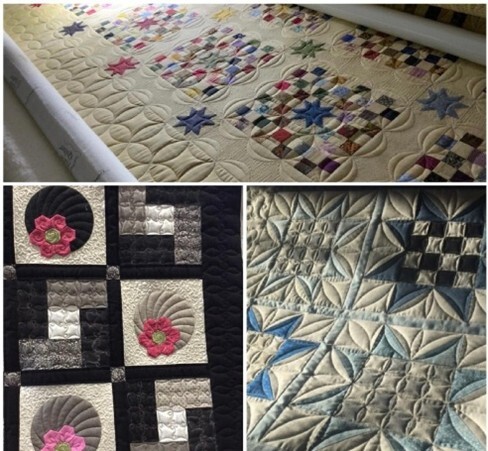
Ruler and Gridwork Class with Wendy Fuller
Friday, November 21, 2025 (Appleton)
or
Saturday, November 22, 2025 (Elkhorn)
9:00 AM – 4:00 PM (lunch included)
Ruler Class Description:
There are so many ways to use rulers! In this small, hands-on class, Wendy will show you tips and tricks for using rulers safely and effectively on your longarm to create straight lines, curves, circles, and arcs/swags.
She’ll teach you how to combine patterns to create complex looking designs. You'll learn how to use these designs for blocks, borders, sashings, and edge to edge options!
You’ll also get plenty of time on the longarm to stitch out some designs and try out different rulers to see which ones you may want to start adding to your quilting tool kit. And, of course, you’ll go home with your practice piece to refer to in the future!
Gridwork Class description:
What is "Grid-work"? It's when you quilt a grid-based design that can use stencils/marking or piecing lines to guide your quilting. Some common examples are "continuous curves" and "orange peel", but the possibilities are endless!
After a little instruction, you'll get to practice designs on the longarm that can be done free motion or with rulers. Wendy will show you how to scale the designs to fit your quilt.
There are so many options for blocks, borders, and background fills!
This class is for beginners through experienced skill levels. There are plenty of options to challenge us all!
AN ADDED NOTE FOR ALL OF WENDY’S CLASSES
Have a project you’re not sure how to quilt? Feel free to bring it along, and you’ll work with Wendy to brainstorm specific ideas that fit both your quilt and your skill level. You’ll go home with a ready-to-execute plan to finish your project!
And please know that all classes are adapted to the experience level of the participants!
These classes fill quickly, so check your calendar and sign up soon!
See the Classes page of our website for even more details on all these classes.
Upcoming Events
It’s almost here … our annual Appleton thankyou event held in partnership with our wonderful neighbor, Going to Pieces Quilt Shop!
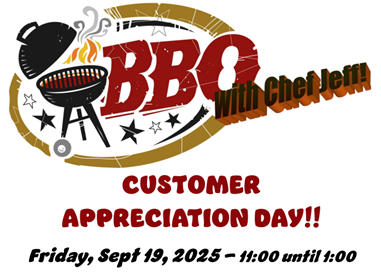
While the free BBQ lunch is only served from 11:00 AM to 1:00 PM, our customer appreciation event lasts all day. There’ll be so much to see and do!
We’ll have fabric loaded on the APQS and Handi Quilter longarms so you can play!
(Ask any questions you may have about pantograph longarm quilting while you’re there.
We’ll gladly show you how it works!)
You can see the Laurastar steam generators in action!
And you can try out our new Ultimate Sewing Chairs!
Plus, we’ll have sales on Superior and Glide thread as well as Handi Quilter products!
Please join us in Appleton! We wouldn’t be here without you!
****************************************************
Wrapping up the month …
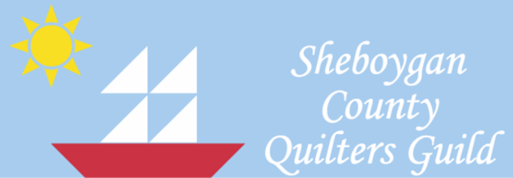
Sheboygan County Quilters Guild Annual Show
“Splashes of Color”
September 27, 2025
9:00 am – 4:00 pm
Sheboygan Lutheran High School
3323 University Drive
Sheboygan, WI 53081
Admission $7
****************************************************
Looking ahead to October …
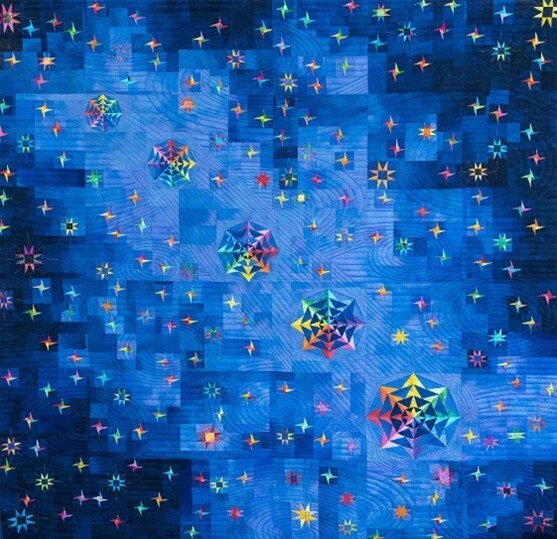
Village Quilters of Lake Bluff/Lake Forest, IL
Quilts from the Village
Friday, October 24, 2025
9:00 AM – 5:00 PM
Saturday, October 25, 2025
9:00 AM – 4:00 PM
College of Lake County
Building F (Physical Education)
19351 West Washington St.
Grayslake, Illinois
Admission: Regular $10
Current Military, Veterans & Students with valid ID $5
children under 12 – free
Please join us! Be sure to stop by and say hi!
SALES!
![]()
This fantastic sale continues!
If it’s time to replace or upgrade your ironing system, stop in and learn all about the benefits of micro-steam technology! Check out Laurastar!
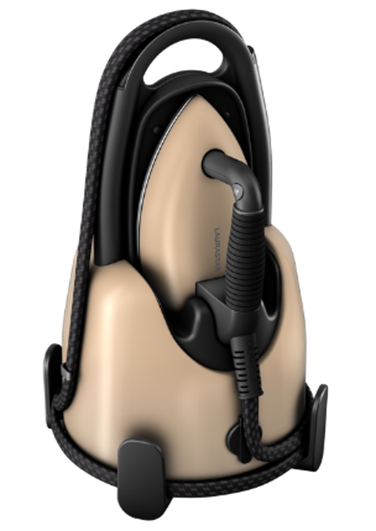
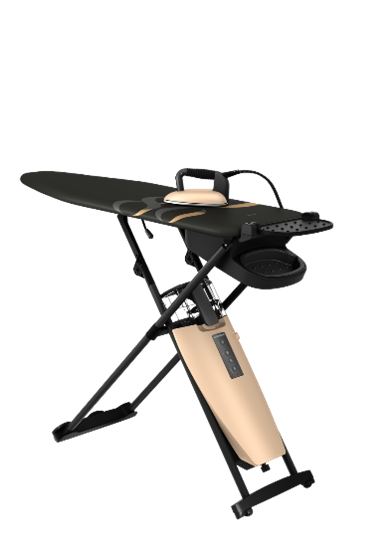
See the Laurastar page of our website for the sale pricing! Then contact us!
The Quilting Central Podcast Update
Have you had a chance to catch the latest episode of The Quilting Central Podcast?

Check out Episode 10: “Would You Rather”. Julie, Cathy and I talk through the ultimate quilting dilemmas, sharing the “why” behind our choices of rotary cutter vs scissors, free-motion vs pantograph, English Paper Piecing vs foundation paper piecing, and so much more!
For a complete listing of all our episodes, check out the Quilting Central Podcast YouTube channel! Be sure to subscribe and comment. We’d love to hear your thoughts!
That’s it! As always …
Please remember, if you ever have ANY questions or want additional information about ANY of the products and services we offer, please call us at (262) 723-6775 or email us at info@QuiltingConnection.com.
You can also visit us online at QuiltingConnection.com or in person at 21 Adams Street in Elkhorn, WI (usually M-F 9-4, please call to confirm we’re open) or 1017 W. Northland in Appleton, WI (W, Th & F 10-4, S 10-3).
Finally, check out our blog at QuiltingConnection.com/blog and our Facebook posts.
And please share your thoughts and questions. I’d love to hear from you!
Angie

